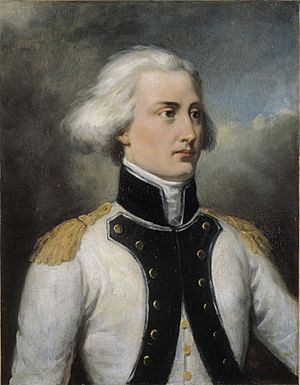Bon-Adrien Jeannot de Moncey facts for kids
Quick facts for kids
Marshal of the Empire
Bon-Adrien Jeannot de Moncey
Duke of Conegliano
|
|
|---|---|

Portrait by Jacques-Luc Barbier-Walbonne (1806)
|
|
| Born | 31 July 1754 Moncey, Franche-Comté, Kingdom of France |
| Died | 20 April 1842 (aged 87) Paris, Kingdom of France |
| Allegiance | |
| Service/ |
Army |
| Years of service | 1774–1814 1816–1823 |
| Rank | Marshal of the Empire |
| Battles/wars | French Revolutionary Wars Napoleonic Wars |
| Other work | Governor of Les Invalides |
Bon-Adrien Jeannot de Moncey (born July 31, 1754 – died April 20, 1842) was a brave French soldier. He became a very important commander during the French Revolutionary Wars and later a Marshal of the Empire under Napoleon. He was also known as the 1st Duke of Conegliano. Later in his life, he became the governor of the Hôtel des Invalides, a special home for veterans in Paris. His name is even carved on the famous Arc de Triomphe in Paris!
Contents
Early Life and Family of Bon-Adrien Jeannot de Moncey
Bon-Adrien Jeannot de Moncey was born on July 31, 1754, in a place called Moncey in France. His father was a lawyer. Young Bon-Adrien really wanted to join the army. He tried twice, but his father made him leave both times! Finally, in 1778, his wish came true, and he joined the French Army.
Moncey's Family Life
Moncey married Charlotte Prospère Remillet. They had three children together:
- Anne-Francoise (born 1791 – died 1842)
- Bon-Louis (born 1792 – died 1817)
- Jeanne-Francoise (born 1807 – died 1853)
His youngest daughter's husband later inherited Moncey's special title, the Duke of Conegliano.
Military Career: Revolutionary and Napoleonic Wars
Moncey was a captain when the French Revolution began in 1791. He quickly became famous for his skills in battles during 1793 and 1794. He fought in the War of the Pyrenees against Spain. In just a few months, he rose from leading a small group of soldiers to commanding a whole army! His victories helped force Spain to make peace with France.
After these successes, Moncey held important commands until 1799. At that time, the government thought he might support the old royal family, so they removed him from his position.
Return to Service Under Napoleon
In 1799, Napoleon came to power in France. This event, called the Coup of 18 Brumaire, brought Moncey back into the army. During Napoleon's campaign in Italy in 1800, Moncey led his troops from Switzerland into Italy. He managed to move horses and cannons over the very difficult Gotthard Pass mountains.
In 1801, Napoleon made him the inspector-general of the French police force, called the National Gendarmerie. When Napoleon became Emperor in 1804, he honored Moncey by making him a Marshal of the Empire. This was a very high military rank. In 1805, Moncey received the Grand Cordon of the Legion of Honour, another important award.
In July 1808, Moncey was given the special title of Duke of Conegliano. This was a rare honor that could be passed down in his family. Since he had no sons who lived, he was allowed to pass this title to his son-in-law later on.
Fighting in Spain: The Peninsular War
Moncey played a big part in the Peninsular War in Spain. In 1808, he led French troops into Spain. He was known for his successful march towards the city of Valencia. However, another French general's defeat at the Battle of Bailén made Moncey's victory less impactful. Moncey then helped Napoleon in battles along the Ebro river and in the Second Siege of Saragossa in 1809.
Defending France in 1814
Moncey chose not to join Napoleon's invasion of Russia in 1812. So, he wasn't part of those difficult campaigns. But when France itself was attacked in 1814, Moncey returned to fight. He bravely led the last battle for Paris on the heights of Montmartre and at the barrier of Clichy.
After Napoleon's defeat, Moncey supported King Louis XVIII. He was made a Peer of France. However, when Napoleon briefly returned to power, Moncey stayed loyal to the King. After Napoleon's final defeat at Waterloo, Moncey was punished. He refused to take part in the trial of another Marshal, Michel Ney. Because of this, he was put in prison and lost his marshal rank and peerage for a time.
Later Years: Bourbon Restoration and July Monarchy
In 1816, King Louis XVIII gave Moncey back his title of marshal. Three years later, he rejoined the Chamber of Peers. His last active military service was in 1823, when he commanded an army corps.
From 1833 to 1842, Moncey served as the governor of the Hôtel des Invalides. This famous building in Paris is a home and hospital for French military veterans.
A Final Tribute to Napoleon
By the 1830s, Moncey was one of the last living marshals from Napoleon's time. On December 15, 1840, Napoleon's body was brought back to France for a grand funeral. Moncey, who was 86 years old and very ill, desperately wanted to be there. He begged his doctor to give him medicine so he could attend. He said, "Doctor, make me live a little longer, I want to honor the Emperor."
He was brought to the ceremony in a wheelchair. When Napoleon's coffin arrived, Moncey tried to stand up but was too weak and fell back. He was then brought closer to the coffin, where he kissed the hilt of Napoleon's sword. After the ceremony, he famously said, "Now let's go home to die." He passed away just over a year later.
See also
 In Spanish: Bon-Adrien Jeannot de Moncey para niños
In Spanish: Bon-Adrien Jeannot de Moncey para niños



